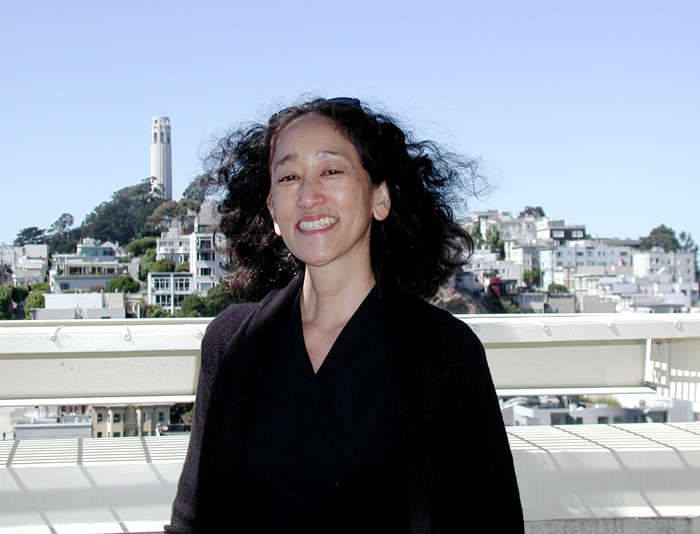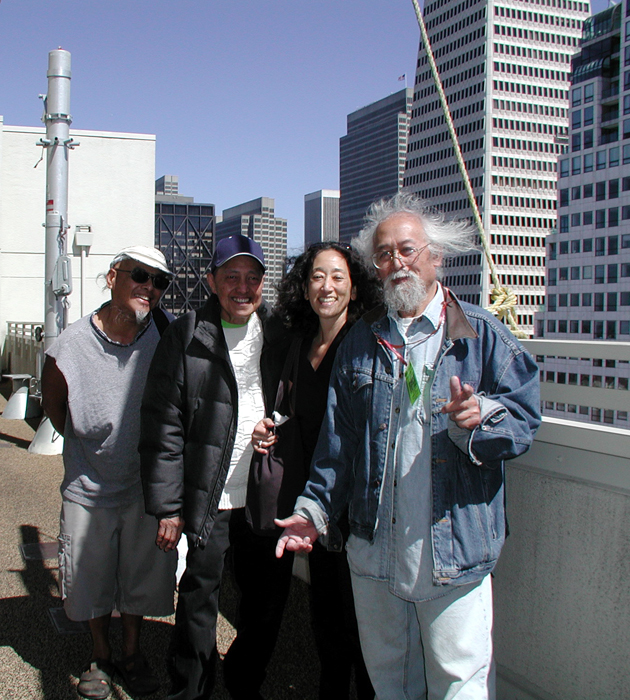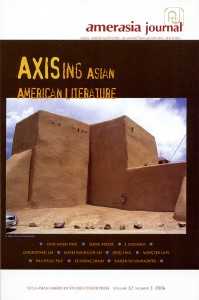We were greeted by the happy news last week that Karen Tei Yamashita’s latest novel I Hotel was named as one of the five finalists for the National Book Award in fiction. It’s definitely a worthy nomination for Yamashita, an innovative writer whose work is always engaging and intellectually challenging. Amerasia has had a wonderful, long-running relationship with Yamashita, going as far back as 1975, when her short story “The Bath” won an Amerasia short story contest. We will be excerpting and linking Yamashita’s contributions to Amerasia on the blog, including creative pieces by her, interviews with her, and an article on her work. Today, we begin with an introduction to I Hotel from the author herself, written exclusively for Amerasia in 2006.

Karen Tei Yamashita standing atop the new International Hotel on the 30th anniversary of the eviction of the former International Hotel's tenants. © Mary Uyematsu Kao, 2007
I Hotel: An Introduction for Amerasia
Karen Tei Yamashita
A long time ago in the 1990s, Amy Ling, then Professor of English and Asian American Literature at the University of Wisconsin, Madison, sent me a questionnaire that she hoped would turn into an essay that would be part of a collection of essays by Asian American writers. I sent back the questionnaire with my simple answers, and this disappointed Amy who wanted more, wrote me back, and sent me an example of a more full-bodied essay written by another author. Comparing my simple answers to another author’s essay, it seemed to me that we both had answered everything with the same ideas, except my answers were in shorthand. At that moment, I thought, well, maybe I could answer Amy with something she really didn’t want at all, something she could reject outright. So I wrote: “Siamese Twins and Mongoloids: Cultural Appropriation and the Deconstruction of Stereotype Via the Absurdity of Humor.” This piece was a critical article about a work of fiction (Siamese Twins and Mongoloids) that I never wrote. In the article, I quoted from the fictitious book, made a critical analysis, all with inserted footnotes and citations. Long before Amy could ever publish the thing, I read it at UCLA for some poetry reading. I distinctly remember Joel Tan and Al Robles were there reading as well. I also remember that Russell Leong came up and said cryptically to me: “That was good. We need to be able to laugh at ourselves.” Not being in the academy, I didn’t realize that I had taken a good jab. As the editor of a journal, Russell may have said ouch, but Amy was always too kind to say. All I thought at the time was that word processing programs had made it easier to put in footnotes, and, lazy as I am, I could now go back to school and become a real scholar. But of course by then, I had gone to fiction hell.
More from “I Hotel: An Introduction for Amerasia” below the fold…
Because of that article, I began thinking about writing that book I never wrote. It was in theme about the Asian American movement, mostly as I knew it set in Los Angeles, but by 1997, I had come to Santa Cruz, and I thought I should explore the Bay Area, where my parents were from and where I was born. Thus, a new center for the project: the International Hotel in Manilatown/ Chinatown. Since that time, I have spent countless hours in the various Asian American archives, spent time wandering around the old sites, read books, viewed films, listened to music, speeches and rallies, and had long and short conversations with over a hundred folks from the time. Researching a period in this way is incredibly fun, so much so that you begin to live it and forget why you began the project in the first place. At some point, I realized that I was supposed to be writing a novel, and the research had to stop. There would be no end to it.
So a few years ago, I slowed the researching down and began to create the structure for the book. I found my research was all over the place, difficult to coalesce into any one storyline or historic chronology. The people I interviewed were definitely in the “movement,” but often times had no idea what others were doing. Their ideas and lives often intersected, but their ideologies were cast in different directions. Their choices took different trajectories, but everyone was there, really there. Thus the structure for this book is based on ten novellas or ten hotels, from the “Eye Hotel” to the “I Hotel.” The various hotels allowed me to tell parallel stories and to experiment with the various narrative voices that for me began to represent each “hotel.”
The draft examples Russell has chosen here represent three of the ten narrative voices. I really appreciate Russell’s editor’s eye in this since, being in the middle of it, I can’t quite see the whole yet. The first narrative voice represented is what I’m calling a collective “we.” The second is the voice of a manong cook, and the third is an imperious brocaded voice of aphorism fashioned as if from the Analects. To date, I’ve drafted seven of the ten novellas. Each novella follows the lives of a different set of characters. The first two pieces are from the first novella, the “Eye Hotel,” that follows the lives of two young men from Chinatown through ten years from 1968 and the Third World strike at San Francisco State College. The third piece is a chapter from the “Inter-national Hotel,” a novella that in part attempts to show ties to Marxist-Leninist practice and to global national liberation movements.
It’s almost there. Many people have joined this journey, but I have finally decided not to name names. My thanks and gratitude cannot be conveyed except through this fiction, but it’s still entirely my fault.
September 2006
This essay appears in Amerasia 32.3 (2006). In addition to this introduction and excerpts from I Hotel, the issue also includes “Forging a North-South Perspective: Nikkei Migration in Karen Tei Yamashita’s Novels” by Jinqi Ling, “Interview with Karen Tei Yamashita” by Te-hsing Shan, and photographs from Yamashita’s journal from her eight-year stay in Brazil.



 Amerasia on Facebook!
Amerasia on Facebook!